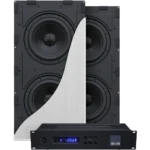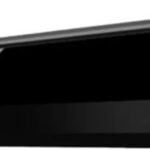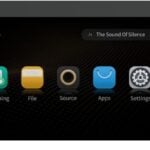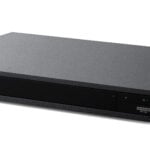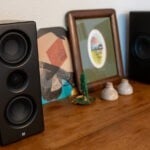Edward J M
Senior HTF Member
- Joined
- Sep 22, 2002
- Messages
- 2,031
Introduction:
I upgraded from a single SVS 20-39 PC-Plus to the new SVS PB2-Plus because I don’t quite have the space for dual cylinders, and I wanted Dolby Labs reference level playback capability in my 2,000 ft3 HT room. At the time of this writing, the PB2-Plus costs $1,200 plus a flat delivery fee of $50 CONUS.
The PB2-Plus was shipped via freight, and weighed 145 pounds including packing materials and the pallet. The packing materials were thick, strong, well engineered, and very protective. The subwoofer is fairly heavy, so two people are recommended to move it into place.
Technical and Design Details:
The owner's manual is comprehensive and well written, with easy to understand set-up, calibration, and tuning advice. There are several basic diagrams showing various connection methods, and good advice on how to avoid common set-up errors. Also included are some recommended DVD and music demo selections. SVS Customer Service Director Ron Stimpson even encourages new owners to send him a personal e-mail if they have questions.
The PB2-Plus external dimensions are roughly 18” wide, 25” tall, and 28” deep, including the integral base-plate. The sub weighs about 105 pounds and feels extremely solid and strong, so enclosure flexing should not ever be a concern.
Despite its size and weight, the PB2-Plus looks quite svelte in the corner of my home theater (HT) room. Design cues are quite modern, and the overall impression is understated, elegant, and masculine. The black finish is an extremely high tech polymer texture that seems virtually impervious to chipping or scratching, and actually contributes to the structural integrity and damping of the enclosure. Fit and finish are very impressive.
The rear flush-mounted Indigo BASH amp is rated at 900 continuous watts. Amp features include auto-on, high/low level inputs, a variable low pass filter control with a defeat switch, an infinitely variable (0-180) phase control, and a four position (25, 20, 16, and "Bypass") subsonic (SS) filter switch.
The PB2-Plus is a ported design which employs two TC-Sounds ultra high output 12" downward-firing "dB12" woofers. Venting is accomplished with three widely flared 4" rear discharge ports. The tune point with three ports open is 25 Hz, and lower states of tune can be achieved by plugging one port (20 Hz) or two ports (16 Hz), and adjusting the SS filter switch accordingly. Two high-density foam port plugs are included with the PB2-Plus.
Equipment Used In The Review:
Polk Audio RT800i, CS400i, f/x 1000, CS245i (x 2)
Denon AVR-3803
Denon DVD-2900
Monster Cable M1.4 bi-wire speaker cable (mains)
Monster Cable MB300 subwoofer interconnect
Monster Cable IDL 100 digital coaxial interconnect (DVD-V)
Signal Cable Analog Two analog interconnects (CD, SACD, DVD-A)
SPL Meter:
A recently calibrated Bruel & Kjaer (B&K) Model 2205 SPL meter set to C-weighted Slow was used for all calibration and frequency response (FR) sweeps. The meter was mounted on a tripod and set at the listening position 11 feet from the PB2-Plus.
All the FR curves in this report have been converted from C-weighted to unweighted using correction factors specific to the B&K meter. It should be noted the B&K correction factors are considerably smaller than the Radio Shack meter correction factors, especially below 25 Hz.
Set-Up and Calibration:
The MB300 subwoofer cable was connected to the left low level input, and the PB2-Plus low pass filter switch was set to "Disabled" to avoid filter cascading. After experimentation, the phase control was set to 180 degrees, as this provided the smoothest transition from the mains.
For Dolby Digital and DTS movie signal processing using the AVR-3803, all speakers were set to "small", and 80 Hz was selected as the subwoofer crossover frequency. The subwoofer channel level was set to -5 to minimize pre-out signal distortion from the receiver. Using the Avia Guide To Home Theater disc, the seven surround speakers were calibrated to 85 dB at Master Volume 00 in order to obtain a Dolby reference level benchmark. The PB2-Plus was calibrated to 88-89 dB.
For CD, SACD, and DVD-A music signal processing using just the DVD-2900 external analog outputs and bass management system, all speakers were set to "small" and the sub was set to "yes". This configuration sets a fixed 80 Hz crossover to the subwoofer. Using the 2900 internal test tones, the five surround speakers were calibrated to 75 dB at Master Volume 00, and the PB2-Plus was calibrated to 77 dB.
Frequency Response and Tuning Configurations:
The FR sweeps consisted of 1/12 octave test tones from 10-100 Hz. Each sweep was conducted off an 80 dB benchmark at the 100 Hz tone. Whenever a port was plugged, the subwoofer channel level was increased 1.5 dB to compensate for the volume loss. Six FR sweeps were conducted as follows, and are shown in the accompanying graphs:
Conventional Tune Configurations:
1) Three ports open, SS switch set to 25 Hz
2) Two ports open, SS switch set to 20 Hz
3) One port open, SS switch set to 16 Hz
Non-Conventional Tune Configurations:
1) Three ports open, SS switch set to 20 Hz
2) Three ports open, SS switch set to 16 Hz
3) Two ports open, SS switch set to 16 Hz


Three ports open and the SS filter set to 25 Hz provides excellent in-room extension to about 22 Hz. While this tune doesn't provide the deepest extension, it does offer maximum output capability, and is recommended for large rooms and/or very high playback levels on DVD.
My favorite tune for sensible (i.e., moderately loud) playback levels is three ports open and the SS filter set to 16 Hz. This configuration provides a strong response in the 20-22 Hz region, utilizes all available port area, and provides good extension to 15 Hz.
Plugging a port and setting the SS filter to 20 Hz provides very strong extension to 15 Hz, and setting the SS filter to 16 Hz further improves extension to about 13 Hz. If you're a real bottom dweller and maximum output is not your first priority, two ports plugged with the SS filter set to 16 Hz provides a still-rising curve all the way to 11 Hz!
It should be noted that "non-conventional" tune configurations increase the potential for bottoming the drivers at extreme levels, so take appropriate and sensible precautions when running the PB2-Plus in these states of tune. If you are shooting for maximum SPL in a large room, SVS strongly recommends three ports open and the SS filter set to 25 Hz, or two ports open and the SS filter set to 20 Hz. These two tune configurations offer the best combination of high output, extension, and woofer protection at extreme levels.
The "Bypass" setting completely disables the subsonic filter. This setting has the highest potential for bottoming the drivers from subsonic signal content. With the incredible extension available with two ports plugged and the SS filter set to 16 Hz, I can’t envision a situation where the Bypass setting would provide any additional benefit.
Subjective Impressions and SPL Levels For DVD Movies:
For maximum SPL testing, I ran the PB2-Plus with three ports open and the SS filter set to 25 Hz. As stated above, at less extreme playback levels I preferred three ports open and the SS filter set to 16 Hz for the additional extension this setting provides.
The PB2-Plus was absolutely effortless on movies, easily handling the most demanding passages and never sounding strained or compressed, even when playing at Dolby reference level.
Dolby reference level is defined as 105 dB bass peaks from any surround channel, and 115 dB bass peaks from the LFE channel. If the surround speakers are set to "small", the subwoofer is required to handle both low passed surround channel bass and the LFE channel. In the event of a simultaneous bass peak in both a surround channel and the LFE channel, the subwoofer would be required to deliver a 121 dB bass peak.
While Master Volume settings are provided below for reference, certain DVDs are mastered far too hot to be comfortably played at Master Volume 00. Common sense and the SPL meter dictated how loud we played any particular DVD. I'm quite certain the PB2-Plus can play even louder than we pushed it, but the overall playback levels were simply approaching the point of discomfort!
Peak SPL monitoring was done with the B&K set on C-weighted Fast, mounted on a tripod at the listening position. The SPL values listed below are C-weighted; to obtain the approximate unweighted SPL for a given passage, ADD 4-5 dB. Clearly, the PB2-Plus was hitting a true 120+ dB on certain passages; this is one BEAST of a subwoofer.
1) LOTR-FOTR EE (DTS-ES 6.1 Discrete), Master Volume -10
The DTS version has the best bass, with more detail and extension than the original theatrical DD version. The PB2-Plus played this demanding DVD with spectacular power and clarity.
Sauron Ring Drop (0:03:58): 115 dB
Ring Wraiths Leaving Castle (0:32:43): 113 dB
Cave Troll Falling Dead (Disc 2) (0:33:28): 116 dB
The Bridge of Khazad-dum & Balrog Fight (Disc 2) (0:37:33-0:41:26): 113-116 dB
2) Monster’s Inc. (DD-EX), Master Volume -9
Sock Explosion (0:18:40): 115 dB
Boo Crying (0:47:50): 117 dB
3) Titan AE (DTS) Master Volume -11
This DVD contains more pure gut wrenching bass than nearly any other, a torture test that makes wimpy subs beg for mercy. The PB2-Plus chewed up and spit out Titan AE without breaking a sweat, in the process rearranging most small items in the house.
In The Ice Field (1:03:34-1:07:22): 115-117 dB
http://www.svsubwoofers.com/images/B...itanAEice4.JPG
Planet Forming: (1:22:13-1:23:34): 114-115 dB
4) The Matrix (DD) Master Volume -4
This DVD has superior bass for a 1999 release, and is deserving of the soundtrack awards. When Morpheus puts his knee through the floor, the PB2-Plus hits you hard in the guts and then waffles your pants with awesome room decay.
Morpheus Knee Smash (0:50:51): 115 dB
http://www.svsubwoofers.com/images/B...inginfight.jpg
Chopper Crash (1:51:03): 115 dB
http://www.svsubwoofers.com/images/B...rexplosion.jpg
Neo and Agent Smith Landing In Fight (1:54:52-58): 113 dB
5) The Haunting (DTS-ES 6.1 Discrete) Master Volume -12
Still my favorite bass demo DVD, The Haunting in DTS has unparalleled dynamic range. The "door knocks" practically gave us concussions, and the extended 22 Hz bass note at "the cold" literally blurred our vision and rattled everything in the room.
Door Knocks (0:38:06): 117 dB
Door Knocks (0:38:52): 116 dB
Door Knocks (0:39:36): 115 dB
Door Knocks (0:40:21): 115 dB
http://www.svsubwoofers.com/images/B...tingcoming.jpg
The Cold (0:39:15): 108 dB
http://www.svsubwoofers.com/images/B...ingthecold.jpg
6) Jurassic Park III (DTS) Master Volume -11
Talk about being right there in the Spino T-Rex fight! We cranked it as high as we dared and the PB2-Plus hung tough, dropping our jaws with tremendous power. Every stomp felt like getting hit in the chest with an 80 pound medicine ball.
Dino Fight: (0:26:40-0:27:25): 113-116 dB
7) Star Wars Episode I: Phantom Menace (DD-EX) Master Volume 00
What HT sub demo is complete without the famous "pod race"? The canyon exits were spine shuddering, and the pod explosion felt like a cannon went off in the room.
Pod Explosion (1:01:39): 114 dB
Pod Racer Passing (1:02:17): 118 dB
Pod Race Canyon Exit (1:05:26): 116 dB
http://www.svsubwoofers.com/images/c...unnelexit2.jpg
8) Star Wars Episode II: Attack Of The Clones (DD-EX) Master Volume -11
George Lucas' sound engineers outdo themselves on Episode II, with the "return to Coruscant" and the "speeder chase" becoming instant subwoofer classics. The PB2-Plus really makes an impressive stretch for clean, effortless, room pressurizing power on these scenes.
Coruscant Ship Passing (0:02:02): 116 dB
Coruscant Ship Exploding (0:03:23): 117 dB
Speeder Drop (0:16:01): 114 dB
Speeder Crash (0:20:53): 115 dB
Column Dropping (2:10:20): 114 dB
9) Pearl Harbor (DTS) Master Volume -10
The percussion blast from the "it's a dud" explosion felt like it was going to blow out the windows, and the ultra deep bass when the Arizona tips over and starts to sink was rendered with extreme authority.
Arizona Explosion (1:29:57): 116 dB
It's A Dud (1:39:03): 114 dB
Arizona Sinking (1:40:00): 112 dB
10) Minority Report (DTS) Master Volume -10
This movie simply gets better with each viewing and the DTS bass track is remarkably strong. The sonic blaster scene made me feel like the guy in the recliner from the old Maxell "Blown Away" ad!
Rocket Backpack Ceiling Crash (0:51:12): 116 dB
Sonic Blaster (0:52:21): 115 dB
Auto Assembly Line (0:54:01-17): 114-116
11) U-571 (DTS) Master Volume -10
Bone crushing bass, there is no other way to describe U-571. The depth charges, ship explosions, and artillery blasts flat out rocked the HT room.
Sub Torpedoed (0:47:47): 114 dB
http://www.svsubwoofers.com/images/c...orpedohit2.jpg
Plane Fly-Over (1:06:24): 113 dB
http://www.svsubwoofers.com/images/c...71flyover2.jpg
Depth Charges (1:19:30-1:20:25): 112-116 dB
http://www.svsubwoofers.com/images/c...pthcharge2.jpg
Destroyer Artillery (1:42:23): 113 dB
Destroyer Torpedoed (1:44:26): 114 dB
Subjective Impressions For Music:
I am fortunate to have nearly ideal room acoustics, and a slab-on-grade concrete floor covered with Armstrong laminate. This floor is acoustically inert and does not transmit any vibration, making it the ideal platform for evaluating the PB2-Plus for both HT and music.
I found the PB2-Plus to be exceptionally neutral, coherent, and articulate on all types of music. It displays excellent attack on transients with absolutely no overhang, and is never sloppy or muddy no matter how complex the bass passage. It blends seamlessly with the mains, reinforcing the lowest octaves without coloring the mid bass. I simply can't get enough of the PB2-Plus on music.
For music evaluation, the PB2-Plus was run with all ports open and the SS filter set to 16 Hz. Music selections were as follows:
1) Kamkiriad (Donald Fagan, Reprise Records). This beautifully recorded CD contains complex electric bass guitar lines that are difficult for a sub to reproduce properly, particularly on Track 3 "Springtime". All bass notes were clean and clear, and the PB2-Plus demonstrated its advantage over just the mains on the deepest notes, lending much more depth and foundation to the soundstage.
2) Gladiator soundtrack (Hans Zimmer/Lisa Gerrard, Decca Records). This is one of my favorite CDs to test the capabilities of a subwoofer, being truly impressive in its depth, power and complexity. The PB2-Plus rendered it perfectly, keeping all the bass notes separate and distinct and hitting the really deep stuff with authority. The sheer emotional impact the PB2-Plus adds to this soundtrack is extraordinary.
3) Giant Steps (John Coltrane, Atlantic Records). A tough test for a sub is the acoustic bass guitar. Paul Chambers launches into a daring one minute solo at the 5-minute mark of "Syeeda’s Song Flute". The fundamentals and harmonics of the bass guitar strings had realistic timbre, and the transition between the mains and the sub was imperceptible.
4) "Toccata & Fugue in d minor" (Organ Works of J.S. Bach, Titanic Records). George Ritchie performs the famous organ movement on the Bedient Organ at Cornerstone, Lincoln, Nebraska. There are strong fundamentals at 18-20 Hz and 30-35 Hz in the first minute of the movement, and the PB2-Plus dug down deep and strong, providing a spine-tingling foundation.
5) "Baby Got Back" (Sir Mix-a-lot - Charlie’s Angels soundtrack, Sony Records). Better known as the "I Like Big Butts" song, this early 90's rap tune has an addictive and throbbing bass line. We cranked it way up to party levels and PB2-Plus happily complied, temporarily turning the HT room into a disco.
6) Everything Must Go (Steely Dan, Reprise Records High Resolution DVD-A). "Godwhacker" opens with an extremely well recorded bass kick drum, and the PB2-Plus nailed the tympanic skin strike and hollow reverb overtones, sounding tight and clean.
7) Rumours (Fleetwood Mac, Warner Brothers Records 1977, 2001 High Resolution DVD-A). The electric bass in "Dreams" is rich and resonant without being thick. The opening kick drum in "The Chain" starts and stops on a dime, and the famous the electric guitar mini-solo in the middle of this song sounds like it was lifted directly from the recording studio.
8) Hell Freezes Over (Eagles, Geffen Records 1994, 1997 DTS 5.1). The drum strikes in "Hotel California", "Life In The Fast Lane", and "Get Over It" have that awesome amplified percussive impact of a live performance. The complex and heavy bass guitar line in "Get Over It" remains detailed and easy to follow even at high playback volumes.
9) Dark Side Of The Moon (Pink Floyd, EMI & Capitol Records 1973, 2003 High Resolution SACD). You haven't heard Dark Side Of The Moon until you've heard the Super Audio version with the lights out. The PB2-Plus is so clean and musical, playing every bass note and instrument exactly as it was intended, allowing the listener to become completely immersed in this masterpiece and providing a very powerful listening experience. When the lights came back on, all I could do was sit and stare at the PB2-Plus in awe.
Summary And Conclusion:
I can say without reservation the SVS PB2-Plus smashes all performance boundaries at its price point. For $1,250 delivered it simply has no competition.
The PB2-Plus provides dual cylinder performance from a single enclosure, it has amazingly flexible tuning options, and is capable of true Dolby reference level playback in moderately sized HT rooms. It is a versatile performer - it can bring down the roof with the most demanding movie passages, and also faithfully render all the nuance of the acoustic bass guitar, kick drum, or pipe organ.
SVS has hinted that the asking price of the PB2-Plus might increase after the introduction phase is over. Get yours now and beat the price increase; this is one purchase decision you will never regret.
Credits:
1) Unweighted conversion factors for B&W SPL meter: DougBW, HTF member
2) 10-100 Hz FR sweep files: Anthony Gomez & Mark Fitzsimmons, HTF members
3) Bass scene waterfall chart hotlinks: SVS
I upgraded from a single SVS 20-39 PC-Plus to the new SVS PB2-Plus because I don’t quite have the space for dual cylinders, and I wanted Dolby Labs reference level playback capability in my 2,000 ft3 HT room. At the time of this writing, the PB2-Plus costs $1,200 plus a flat delivery fee of $50 CONUS.
The PB2-Plus was shipped via freight, and weighed 145 pounds including packing materials and the pallet. The packing materials were thick, strong, well engineered, and very protective. The subwoofer is fairly heavy, so two people are recommended to move it into place.
Technical and Design Details:
The owner's manual is comprehensive and well written, with easy to understand set-up, calibration, and tuning advice. There are several basic diagrams showing various connection methods, and good advice on how to avoid common set-up errors. Also included are some recommended DVD and music demo selections. SVS Customer Service Director Ron Stimpson even encourages new owners to send him a personal e-mail if they have questions.
The PB2-Plus external dimensions are roughly 18” wide, 25” tall, and 28” deep, including the integral base-plate. The sub weighs about 105 pounds and feels extremely solid and strong, so enclosure flexing should not ever be a concern.
Despite its size and weight, the PB2-Plus looks quite svelte in the corner of my home theater (HT) room. Design cues are quite modern, and the overall impression is understated, elegant, and masculine. The black finish is an extremely high tech polymer texture that seems virtually impervious to chipping or scratching, and actually contributes to the structural integrity and damping of the enclosure. Fit and finish are very impressive.
The rear flush-mounted Indigo BASH amp is rated at 900 continuous watts. Amp features include auto-on, high/low level inputs, a variable low pass filter control with a defeat switch, an infinitely variable (0-180) phase control, and a four position (25, 20, 16, and "Bypass") subsonic (SS) filter switch.
The PB2-Plus is a ported design which employs two TC-Sounds ultra high output 12" downward-firing "dB12" woofers. Venting is accomplished with three widely flared 4" rear discharge ports. The tune point with three ports open is 25 Hz, and lower states of tune can be achieved by plugging one port (20 Hz) or two ports (16 Hz), and adjusting the SS filter switch accordingly. Two high-density foam port plugs are included with the PB2-Plus.
Equipment Used In The Review:
Polk Audio RT800i, CS400i, f/x 1000, CS245i (x 2)
Denon AVR-3803
Denon DVD-2900
Monster Cable M1.4 bi-wire speaker cable (mains)
Monster Cable MB300 subwoofer interconnect
Monster Cable IDL 100 digital coaxial interconnect (DVD-V)
Signal Cable Analog Two analog interconnects (CD, SACD, DVD-A)
SPL Meter:
A recently calibrated Bruel & Kjaer (B&K) Model 2205 SPL meter set to C-weighted Slow was used for all calibration and frequency response (FR) sweeps. The meter was mounted on a tripod and set at the listening position 11 feet from the PB2-Plus.
All the FR curves in this report have been converted from C-weighted to unweighted using correction factors specific to the B&K meter. It should be noted the B&K correction factors are considerably smaller than the Radio Shack meter correction factors, especially below 25 Hz.
Set-Up and Calibration:
The MB300 subwoofer cable was connected to the left low level input, and the PB2-Plus low pass filter switch was set to "Disabled" to avoid filter cascading. After experimentation, the phase control was set to 180 degrees, as this provided the smoothest transition from the mains.
For Dolby Digital and DTS movie signal processing using the AVR-3803, all speakers were set to "small", and 80 Hz was selected as the subwoofer crossover frequency. The subwoofer channel level was set to -5 to minimize pre-out signal distortion from the receiver. Using the Avia Guide To Home Theater disc, the seven surround speakers were calibrated to 85 dB at Master Volume 00 in order to obtain a Dolby reference level benchmark. The PB2-Plus was calibrated to 88-89 dB.
For CD, SACD, and DVD-A music signal processing using just the DVD-2900 external analog outputs and bass management system, all speakers were set to "small" and the sub was set to "yes". This configuration sets a fixed 80 Hz crossover to the subwoofer. Using the 2900 internal test tones, the five surround speakers were calibrated to 75 dB at Master Volume 00, and the PB2-Plus was calibrated to 77 dB.
Frequency Response and Tuning Configurations:
The FR sweeps consisted of 1/12 octave test tones from 10-100 Hz. Each sweep was conducted off an 80 dB benchmark at the 100 Hz tone. Whenever a port was plugged, the subwoofer channel level was increased 1.5 dB to compensate for the volume loss. Six FR sweeps were conducted as follows, and are shown in the accompanying graphs:
Conventional Tune Configurations:
1) Three ports open, SS switch set to 25 Hz
2) Two ports open, SS switch set to 20 Hz
3) One port open, SS switch set to 16 Hz
Non-Conventional Tune Configurations:
1) Three ports open, SS switch set to 20 Hz
2) Three ports open, SS switch set to 16 Hz
3) Two ports open, SS switch set to 16 Hz


Three ports open and the SS filter set to 25 Hz provides excellent in-room extension to about 22 Hz. While this tune doesn't provide the deepest extension, it does offer maximum output capability, and is recommended for large rooms and/or very high playback levels on DVD.
My favorite tune for sensible (i.e., moderately loud) playback levels is three ports open and the SS filter set to 16 Hz. This configuration provides a strong response in the 20-22 Hz region, utilizes all available port area, and provides good extension to 15 Hz.
Plugging a port and setting the SS filter to 20 Hz provides very strong extension to 15 Hz, and setting the SS filter to 16 Hz further improves extension to about 13 Hz. If you're a real bottom dweller and maximum output is not your first priority, two ports plugged with the SS filter set to 16 Hz provides a still-rising curve all the way to 11 Hz!
It should be noted that "non-conventional" tune configurations increase the potential for bottoming the drivers at extreme levels, so take appropriate and sensible precautions when running the PB2-Plus in these states of tune. If you are shooting for maximum SPL in a large room, SVS strongly recommends three ports open and the SS filter set to 25 Hz, or two ports open and the SS filter set to 20 Hz. These two tune configurations offer the best combination of high output, extension, and woofer protection at extreme levels.
The "Bypass" setting completely disables the subsonic filter. This setting has the highest potential for bottoming the drivers from subsonic signal content. With the incredible extension available with two ports plugged and the SS filter set to 16 Hz, I can’t envision a situation where the Bypass setting would provide any additional benefit.
Subjective Impressions and SPL Levels For DVD Movies:
For maximum SPL testing, I ran the PB2-Plus with three ports open and the SS filter set to 25 Hz. As stated above, at less extreme playback levels I preferred three ports open and the SS filter set to 16 Hz for the additional extension this setting provides.
The PB2-Plus was absolutely effortless on movies, easily handling the most demanding passages and never sounding strained or compressed, even when playing at Dolby reference level.
Dolby reference level is defined as 105 dB bass peaks from any surround channel, and 115 dB bass peaks from the LFE channel. If the surround speakers are set to "small", the subwoofer is required to handle both low passed surround channel bass and the LFE channel. In the event of a simultaneous bass peak in both a surround channel and the LFE channel, the subwoofer would be required to deliver a 121 dB bass peak.
While Master Volume settings are provided below for reference, certain DVDs are mastered far too hot to be comfortably played at Master Volume 00. Common sense and the SPL meter dictated how loud we played any particular DVD. I'm quite certain the PB2-Plus can play even louder than we pushed it, but the overall playback levels were simply approaching the point of discomfort!
Peak SPL monitoring was done with the B&K set on C-weighted Fast, mounted on a tripod at the listening position. The SPL values listed below are C-weighted; to obtain the approximate unweighted SPL for a given passage, ADD 4-5 dB. Clearly, the PB2-Plus was hitting a true 120+ dB on certain passages; this is one BEAST of a subwoofer.
1) LOTR-FOTR EE (DTS-ES 6.1 Discrete), Master Volume -10
The DTS version has the best bass, with more detail and extension than the original theatrical DD version. The PB2-Plus played this demanding DVD with spectacular power and clarity.
Sauron Ring Drop (0:03:58): 115 dB
Ring Wraiths Leaving Castle (0:32:43): 113 dB
Cave Troll Falling Dead (Disc 2) (0:33:28): 116 dB
The Bridge of Khazad-dum & Balrog Fight (Disc 2) (0:37:33-0:41:26): 113-116 dB
2) Monster’s Inc. (DD-EX), Master Volume -9
Sock Explosion (0:18:40): 115 dB
Boo Crying (0:47:50): 117 dB
3) Titan AE (DTS) Master Volume -11
This DVD contains more pure gut wrenching bass than nearly any other, a torture test that makes wimpy subs beg for mercy. The PB2-Plus chewed up and spit out Titan AE without breaking a sweat, in the process rearranging most small items in the house.
In The Ice Field (1:03:34-1:07:22): 115-117 dB
http://www.svsubwoofers.com/images/B...itanAEice4.JPG
Planet Forming: (1:22:13-1:23:34): 114-115 dB
4) The Matrix (DD) Master Volume -4
This DVD has superior bass for a 1999 release, and is deserving of the soundtrack awards. When Morpheus puts his knee through the floor, the PB2-Plus hits you hard in the guts and then waffles your pants with awesome room decay.
Morpheus Knee Smash (0:50:51): 115 dB
http://www.svsubwoofers.com/images/B...inginfight.jpg
Chopper Crash (1:51:03): 115 dB
http://www.svsubwoofers.com/images/B...rexplosion.jpg
Neo and Agent Smith Landing In Fight (1:54:52-58): 113 dB
5) The Haunting (DTS-ES 6.1 Discrete) Master Volume -12
Still my favorite bass demo DVD, The Haunting in DTS has unparalleled dynamic range. The "door knocks" practically gave us concussions, and the extended 22 Hz bass note at "the cold" literally blurred our vision and rattled everything in the room.
Door Knocks (0:38:06): 117 dB
Door Knocks (0:38:52): 116 dB
Door Knocks (0:39:36): 115 dB
Door Knocks (0:40:21): 115 dB
http://www.svsubwoofers.com/images/B...tingcoming.jpg
The Cold (0:39:15): 108 dB
http://www.svsubwoofers.com/images/B...ingthecold.jpg
6) Jurassic Park III (DTS) Master Volume -11
Talk about being right there in the Spino T-Rex fight! We cranked it as high as we dared and the PB2-Plus hung tough, dropping our jaws with tremendous power. Every stomp felt like getting hit in the chest with an 80 pound medicine ball.
Dino Fight: (0:26:40-0:27:25): 113-116 dB
7) Star Wars Episode I: Phantom Menace (DD-EX) Master Volume 00
What HT sub demo is complete without the famous "pod race"? The canyon exits were spine shuddering, and the pod explosion felt like a cannon went off in the room.
Pod Explosion (1:01:39): 114 dB
Pod Racer Passing (1:02:17): 118 dB
Pod Race Canyon Exit (1:05:26): 116 dB
http://www.svsubwoofers.com/images/c...unnelexit2.jpg
8) Star Wars Episode II: Attack Of The Clones (DD-EX) Master Volume -11
George Lucas' sound engineers outdo themselves on Episode II, with the "return to Coruscant" and the "speeder chase" becoming instant subwoofer classics. The PB2-Plus really makes an impressive stretch for clean, effortless, room pressurizing power on these scenes.
Coruscant Ship Passing (0:02:02): 116 dB
Coruscant Ship Exploding (0:03:23): 117 dB
Speeder Drop (0:16:01): 114 dB
Speeder Crash (0:20:53): 115 dB
Column Dropping (2:10:20): 114 dB
9) Pearl Harbor (DTS) Master Volume -10
The percussion blast from the "it's a dud" explosion felt like it was going to blow out the windows, and the ultra deep bass when the Arizona tips over and starts to sink was rendered with extreme authority.
Arizona Explosion (1:29:57): 116 dB
It's A Dud (1:39:03): 114 dB
Arizona Sinking (1:40:00): 112 dB
10) Minority Report (DTS) Master Volume -10
This movie simply gets better with each viewing and the DTS bass track is remarkably strong. The sonic blaster scene made me feel like the guy in the recliner from the old Maxell "Blown Away" ad!
Rocket Backpack Ceiling Crash (0:51:12): 116 dB
Sonic Blaster (0:52:21): 115 dB
Auto Assembly Line (0:54:01-17): 114-116
11) U-571 (DTS) Master Volume -10
Bone crushing bass, there is no other way to describe U-571. The depth charges, ship explosions, and artillery blasts flat out rocked the HT room.
Sub Torpedoed (0:47:47): 114 dB
http://www.svsubwoofers.com/images/c...orpedohit2.jpg
Plane Fly-Over (1:06:24): 113 dB
http://www.svsubwoofers.com/images/c...71flyover2.jpg
Depth Charges (1:19:30-1:20:25): 112-116 dB
http://www.svsubwoofers.com/images/c...pthcharge2.jpg
Destroyer Artillery (1:42:23): 113 dB
Destroyer Torpedoed (1:44:26): 114 dB
Subjective Impressions For Music:
I am fortunate to have nearly ideal room acoustics, and a slab-on-grade concrete floor covered with Armstrong laminate. This floor is acoustically inert and does not transmit any vibration, making it the ideal platform for evaluating the PB2-Plus for both HT and music.
I found the PB2-Plus to be exceptionally neutral, coherent, and articulate on all types of music. It displays excellent attack on transients with absolutely no overhang, and is never sloppy or muddy no matter how complex the bass passage. It blends seamlessly with the mains, reinforcing the lowest octaves without coloring the mid bass. I simply can't get enough of the PB2-Plus on music.
For music evaluation, the PB2-Plus was run with all ports open and the SS filter set to 16 Hz. Music selections were as follows:
1) Kamkiriad (Donald Fagan, Reprise Records). This beautifully recorded CD contains complex electric bass guitar lines that are difficult for a sub to reproduce properly, particularly on Track 3 "Springtime". All bass notes were clean and clear, and the PB2-Plus demonstrated its advantage over just the mains on the deepest notes, lending much more depth and foundation to the soundstage.
2) Gladiator soundtrack (Hans Zimmer/Lisa Gerrard, Decca Records). This is one of my favorite CDs to test the capabilities of a subwoofer, being truly impressive in its depth, power and complexity. The PB2-Plus rendered it perfectly, keeping all the bass notes separate and distinct and hitting the really deep stuff with authority. The sheer emotional impact the PB2-Plus adds to this soundtrack is extraordinary.
3) Giant Steps (John Coltrane, Atlantic Records). A tough test for a sub is the acoustic bass guitar. Paul Chambers launches into a daring one minute solo at the 5-minute mark of "Syeeda’s Song Flute". The fundamentals and harmonics of the bass guitar strings had realistic timbre, and the transition between the mains and the sub was imperceptible.
4) "Toccata & Fugue in d minor" (Organ Works of J.S. Bach, Titanic Records). George Ritchie performs the famous organ movement on the Bedient Organ at Cornerstone, Lincoln, Nebraska. There are strong fundamentals at 18-20 Hz and 30-35 Hz in the first minute of the movement, and the PB2-Plus dug down deep and strong, providing a spine-tingling foundation.
5) "Baby Got Back" (Sir Mix-a-lot - Charlie’s Angels soundtrack, Sony Records). Better known as the "I Like Big Butts" song, this early 90's rap tune has an addictive and throbbing bass line. We cranked it way up to party levels and PB2-Plus happily complied, temporarily turning the HT room into a disco.
6) Everything Must Go (Steely Dan, Reprise Records High Resolution DVD-A). "Godwhacker" opens with an extremely well recorded bass kick drum, and the PB2-Plus nailed the tympanic skin strike and hollow reverb overtones, sounding tight and clean.
7) Rumours (Fleetwood Mac, Warner Brothers Records 1977, 2001 High Resolution DVD-A). The electric bass in "Dreams" is rich and resonant without being thick. The opening kick drum in "The Chain" starts and stops on a dime, and the famous the electric guitar mini-solo in the middle of this song sounds like it was lifted directly from the recording studio.
8) Hell Freezes Over (Eagles, Geffen Records 1994, 1997 DTS 5.1). The drum strikes in "Hotel California", "Life In The Fast Lane", and "Get Over It" have that awesome amplified percussive impact of a live performance. The complex and heavy bass guitar line in "Get Over It" remains detailed and easy to follow even at high playback volumes.
9) Dark Side Of The Moon (Pink Floyd, EMI & Capitol Records 1973, 2003 High Resolution SACD). You haven't heard Dark Side Of The Moon until you've heard the Super Audio version with the lights out. The PB2-Plus is so clean and musical, playing every bass note and instrument exactly as it was intended, allowing the listener to become completely immersed in this masterpiece and providing a very powerful listening experience. When the lights came back on, all I could do was sit and stare at the PB2-Plus in awe.
Summary And Conclusion:
I can say without reservation the SVS PB2-Plus smashes all performance boundaries at its price point. For $1,250 delivered it simply has no competition.
The PB2-Plus provides dual cylinder performance from a single enclosure, it has amazingly flexible tuning options, and is capable of true Dolby reference level playback in moderately sized HT rooms. It is a versatile performer - it can bring down the roof with the most demanding movie passages, and also faithfully render all the nuance of the acoustic bass guitar, kick drum, or pipe organ.
SVS has hinted that the asking price of the PB2-Plus might increase after the introduction phase is over. Get yours now and beat the price increase; this is one purchase decision you will never regret.
Credits:
1) Unweighted conversion factors for B&W SPL meter: DougBW, HTF member
2) 10-100 Hz FR sweep files: Anthony Gomez & Mark Fitzsimmons, HTF members
3) Bass scene waterfall chart hotlinks: SVS

 Just one more sub.
Just one more sub.